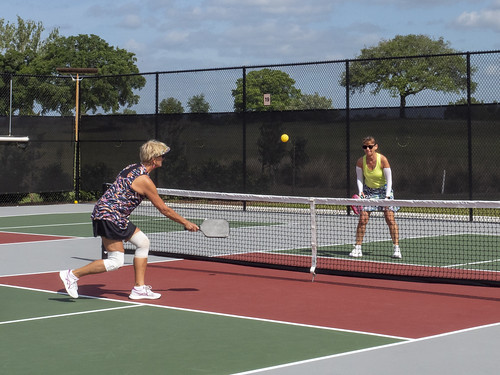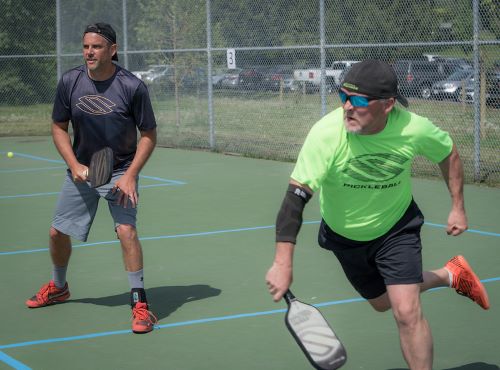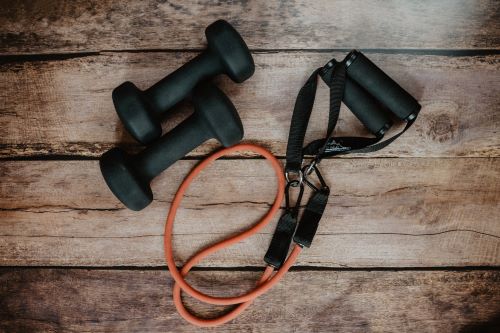Pickleball isn’t the most challenging sport in the world, and pickleball players aren’t the best athletes either. A good percentage of pickleball players are actually physically unfit, elderly, or haven’t played sports in a while. If you’re any of these, then you probably find yourself huffing and puffing on the court, trying to catch your breath during a game.
You can enjoy the game better if you’re able to last longer on the court, and for that, you’ll need to build endurance. It doesn’t matter if it’s because you run out of breath too fast, want to exercise outside the court, or just want to become a better player. Learning how to build endurance for pickleball will go a long way inside and outside the court.
In this article, we’ll go over the best endurance exercises for pickleball and talk about how you can measure your endurance.
How to Build Endurance for Pickleball?
Endurance is the ability to keep doing an activity over a longer period of time. If you find yourself running out of breath after playing pickleball for 15 minutes, you definitely need to increase your endurance.
Building endurance for any sport takes a lot of time, dedication, and repetition. While there are a lot of ways to build your endurance both in and out of the court, not all of these exercises are equal for building stamina in pickleball.
The more you play pickleball, the more familiar you become with the game, and your body will also get used to that specific kind of fatigue. However, you might not experience as much growth playing the game as you would doing a properly timed workout. Workouts that are structured to push you to your limits are much more effective at improving your endurance. But, these workouts have to be related to or useful for pickleball.
For example, swimming can build endurance, but it doesn’t train or simulate the same kind of motions you need for pickleball. Exercises good for pickleball are short sprints, side to side hops, zigzag cone drills, and so on. These movements are much more useful because these are the kind of moves you would be doing while playing pickleball.
Cardiorespiratory Fitness and Endurance for Pickleball
Cardiorespiratory fitness is all about how “in shape” your lungs are. Think of it like this: if your body is a car, your lungs are the gas pedal, controlling how much fuel gets to the engine. The more fit your lungs are, the better they can provide oxygen and fuel your body and your working muscles. It helps you breathe easy, and go strong during your workouts, rather than huffing and puffing and needing frequent breaks.
Now, when it comes to pickleball, cardiorespiratory fitness makes a world of difference. Pickleball isn’t a slow, steady game. It’s dynamic and fast-paced. It demands quick bursts of energy, and that’s where healthy and fit lungs come in. Players with great cardiorespiratory fitness can keep going strong, game after game, without losing their breaths.
They can dash to reach the ball, recover quickly, and be ready for the next shot. In other words, they’ve got the stamina and endurance to stay in the game when others would start giving up to catch their breath. That extra endurance can spell the difference between a good shot and a great one, a close game and a clear win. It’s a game-changer.
Cardiorespiratory vs Cardiovascular for Pickleball Endurance
In the fitness world, the terms “cardiovascular” and “cardiorespiratory” often get used interchangeably. But they’re not the same thing. Both are critical for a healthy body, but when it comes to endurance and sports like pickleball or tennis, cardiorespiratory fitness steals the show. Even though they’re closely related, the training methods for these two types of fitness are slightly different.
The heart mainly directs cardiovascular function, enabling it to maintain a high heart rate without quickly becoming exhausted. Exercises that promote cardiovascular health are jogging, swimming, or cycling. You get a high heart rate from these activities, but because the pace is steady, you won’t quickly run out of breath.
On the other hand, cardiorespiratory fitness is about the strength and fitness level of your lungs and their ability to breathe normally through intense tasks, like sprinting. While your heart rate still increases during a sprint or a high-intensity exercise, chances are you’ll take a break because you’re out of breath and not because your heart can’t keep up. This is why you need strength in your lungs—to increase their ability to circulate oxygen around your body and keep you feeling less fatigued.
So, is there a way to track and measure your cardiorespiratory fitness level?
VO2 Max: The Best Indicator for Cardiorespiratory Endurance
VO2 max stands for the maximum volume (V) of oxygen (O2) that your body can use when it’s pushed to its physical limits. Your muscles need oxygen to produce energy, so the more power you need, the more oxygen you require. A higher VO2 max means that you can play harder and longer without feeling tired or getting out of breath.
Because this is an indicator of the amount of oxygen in your body, the VO2 max is measured in milliliters of oxygen per kilogram of body weight per minute (mL/kg/min). It is a measure of how much oxygen your body can use during exercise within a minute, relative to your body weight.
If you don’t have a smartwatch with a VO2 max feature, don’t fret. Continue with the section below to understand how the watch measures the VO2 max and what the numbers mean.
How to Measure VO2 Max
Unfortunately, VO2 max isn’t a very popular metric, so you might not know where to find it on your smartwatch. So, we found the most up-to-date steps for finding your VO2 max for every kind of smartwatch we mentioned. These steps are the latest as of July 2023.
Steps for Finding Vo2 Max on Apple Watch:
- Make sure that your Apple Watch is running watchOS 7.2 or later.
- Go to the Health app on your iPhone.
- Tap Browse > Heart > Cardio Fitness.
- If you have not yet logged any outdoor workouts, you will need to do so before your VO2 max can be calculated.
- Once you have logged some outdoor workouts, your VO2 max will be displayed.
Steps for Finding Vo2 Max on Garmin:
- Make sure that your Garmin device is running the latest software.
- Go to the Activities app on your device.
- Select a running or cycling activity.
- Once the activity is complete, your VO2 max will be displayed.
Steps for Finding Vo2 Max on Fit Bit:
- Make sure that your Fitbit device is running the latest software.
- Go to the Today tab on your device.
- Scroll down and tap Cardio Fitness.
- Your VO2 max will be displayed.
Steps for Finding Vo2 Max on Samsung:
- Make sure that your Samsung device is running the latest software.
- Go to the Samsung Health app on your device.
- Tap Measure > VO2 max.
- Follow the on-screen instructions to complete the test.
Now that you know what your VO2 max is, it’s time to compare where your measurement lands overall. Are you normal? Bad? Or decent?
The VO2 Max Spectrum for Endurance
Just like most things related to fitness, there’s a spectrum when it comes to the amount of oxygen your body can use. That spectrum is a table categorized from excellent to very poor VO2 max levels, for every single age group from 20 to 60+ year-olds.
Here is a general overview of the VO2 max spectrum:
| Age Group | Range | ||||||
| Excellent | Good | Above Average | Average | Below Average | Poor | Very Poor | |
| 20 – 29 | > 60 | 54 – 60 | 48 – 53 | 42 – 47 | 36 – 41 | 30 – 35 | < 30 |
| 30 – 39 | > 56 | 50 – 56 | 44 – 49 | 38 – 43 | 32 – 37 | 26 – 31 | < 26 |
| 40 – 49 | > 51 | 45 – 51 | 40 – 44 | 34 – 39 | 28 – 33 | 22 – 27 | < 22 |
| 50 – 59 | > 46 | 41 – 46 | 36 – 40 | 30 – 35 | 24 – 29 | 19 – 23 | < 19 |
| 60+ | > 41 | 36 – 41 | 31 – 35 | 26 – 30 | 21 – 25 | 16 – 20 | < 16 |
Best Endurance Exercises for Pickleball
Below are the best exercises for increasing your endurance for playing pickleball. Your goal with these exercises is to sweat a lot and lose your breath. To do that, you should focus on exerting as much effort as you can in short bursts, and rest properly when you feel like catching your breath.
Zigzag circuits
This drill can help improve your agility and quickness, which are essential in pickleball. Set up several cones in a zigzag pattern and sprint from one cone to the next, changing direction quickly at each cone. This will help improve your ability to change direction quickly during a game.
Ramp up the speed and explosiveness of your turns as best as you can until you start running out of breath. Take some rest and then repeat the drill until you’re completely exhausted. Doing 20 to 30 minutes of high-intensity zigzag circuits goes a long way and oftentimes takes players by surprise with how tiring it is.
Side-to-side hopping
Side-to-side hopping is a simple and effective exercise for improving lower body explosiveness and balance. It mimics the lateral movements you need to make on the pickleball court, where you often have to change directions by hopping to another side.
Here’s how you do it:
- Take a step forward with your left leg.
- Lower your body. Your right leg should be in a kneeling position, but your right knee shouldn’t touch the ground.
- Your left leg should be at a 90 degree angle. Move your left leg forward or backward if you need help getting into position.
- Once you’re ready, use your left leg to push your body to the right side, then jump to the right.
- Land with your right leg forward and your left leg backward.
- Go back into the kneeling position, this time with your left leg almost kneeling and your right leg 90 degrees to the ground.
With regular practice, side-to-side hopping can enhance your ability to move swiftly across the pickleball court and change directions, giving you an edge over your opponents. It also challenges your coordination and can help build balance and endurance. As you’re maintaining a consistent level of high-intensity movement throughout the exercise.
Sprints
Sprints are another great way to improve cardiorespiratory fitness. Instead of jogging at a steady pace, you start by walking slowly and then sprinting for 5 to 10 seconds as fast as you can. Repeating this 5 times will surely put you out of breath. Doing 5 to 10 seconds of fast sprints is important when running after the ball in a game of pickleball.
Final Words
At the end of the day, building endurance takes a lot of sweat, time, and determination. If you feel overwhelmed by the information above. You can always stick to simply playing more games than usual and always pushing yourself to the limit every game. You’ll notice improvements easily within months as long as you push yourself to do more every time you step onto the pickleball court.




































